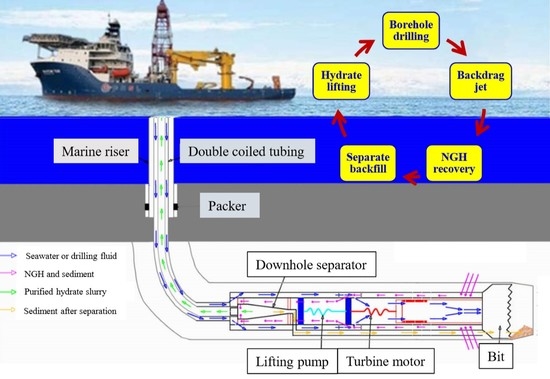Analysis of Multi-Phase Mixed Slurry Horizontal Section Migration Efficiency in Natural Gas Hydrate Drilling and Production Method Based on Double-Layer Continuous Pipe and Double Gradient Drilling
Abstract
:1. Introduction
2. NGH Drilling and Production Method with DDG
2.1. The DDG Method
2.2. Dynamic Regulation of Wellbore Pressure
3. Analysis of the Mechanism of the NGH Slurry Migration in Horizontal Section
3.1. Analysis of the NGH Slurry Migration State in Horizontal Section
3.1.1. Migration State under Different Working Conditions
3.1.2. Slurry Migration State in Different Methods
3.2. Force Analysis of Solid Particles in Horizontal Section
- 1.
- The gravity G and buoyancy of the solid particles in the drilling fluid are:where: is particle size of the solid phase, m; is density of the solid phase particles, kg/m3; is drilling fluid density, kg/m3.
- 2.
- The hydraulic drag force and hydraulic lift force of the solid particles in the drilling fluid are:where: ; is drag coefficient; is the lift coefficient; is a constant related to , when ≤ 0.5 mm, = 0.5 mm; When mm, ; When ; and is constant coefficient; is instantaneous flow velocity acting on the particles, m/s.
- 3.
- Cohesion between particles is:where: is constant coefficient; is dry bulk density of the particles, kg/m3; is stable dry bulk density of the particles, kg/m3; is the bonding force parameter, for natural sand, generally take 1.7510−6 × m3/s2.
- 4.
- Pressure gradient force
4. Establishment of Numeric Simulation Model of NGH Slurry Migration Process
4.1. Physical Model
4.1.1. Basic Assumptions
- The fluid does not undergo a phase change during the flow process. The wellbore is in adiabatic, and there is no heat exchange between the fluids in the annulus.
- Solid particles have the same diameter, density and friction angle, and are spherical rigid particles.
- Numeric simulation analysis of the fluid at the entrance is fully developed fluid.
4.1.2. Physical Model Building
4.2. Mathematical Model of Slurry Migration Process
4.2.1. Selection of Turbulence Model for Horizontal Slurry Migration Process
4.2.2. Selection of Multiphase Flow Models
5. Analysis of Numeric Simulation Results of NGH Slurry Migration Process
5.1. Analysis of the Efficiency of the DDG Method under Different Working Conditions
5.2. Comparative Analysis of Different Methods of Transport Efficiency under the Same Working Conditions
6. Conclusions
- The greater the NGH abundance, the lower the deposition rate inside the migration channel. When the NGH abundance is 0.8, no sediment will appear at the bottom of the migration channel. The greater the flow rate of drilling fluid, the lower the deposition rate inside the migration channel. When the mixture flow rate is 800 L/min, the migration channel still has sedimentation. When the flow rate reaches 1100 L/min, solid particles are mainly distributed in the upper and middle part of the migration channel, and almost no solid particles are deposited at the bottom of the channel. In addition, the smaller the diameter of the solid particles, the higher the migration efficiency. When there is a lift pump, the migration efficiency of solid particles is higher than that without a lift pump.
- Under the same conditions, the migration efficiency of the multiphase mixed slurry of sediment and NGH inside the DDG method is higher than that of the traditional drilling method. The advantages of the DDG method are more obvious when there is a lifting pump. In addition, since the multiphase mixed slurry of sediment and NGH in the DDG method migrations in the double-layer continuous pipe, its flow rate will not be limited, which will be more conducive to the migration of NGH particles.
Author Contributions
Funding
Conflicts of Interest
Nomenclature
| NGH | Natural gas hydrate |
| SSFM | Solid-state fluidized mining |
| DDG | Double-layer continuous-pipe double-gradient drilling |
| Thickness of NGH formation | |
| Radius of NGH formation | |
| Density of seawater | |
| Density of isolation fluid | |
| Density of drilling fluid | |
| Height of seawater | |
| Height of isolation fluid | |
| Respective height of drilling fluid | |
| Bottom pressure of the well bore | |
| Acceleration of gravity | |
| Safety differential pressure window of formation pressure | |
| Formation fracture pressure | |
| Formation loss pressure | |
| Formation pore pressure | |
| Formation collapse pressure | |
| Pressure value after the bottom pressure of the well bore is reduced | |
| Reduced height of the drilling fluid hydrostatic column | |
| Pressure value after the bottom pressure of the well bore increases | |
| Increased height of the hydrostatic column | |
| Flow rate of drilling fluid flowing from the outer pipe of the double-layer continuous pipe in a balanced state | |
| Flow rate returning from the inner tube of the double-layer continuous tube under equilibrium | |
| The increase of the flow rate returned from the inner tube of the double-layer continuous tube after adjusting the speed of the lift pump | |
| the flow rate returned from the inner tube of the double-layer continuous tube in condition 1 | |
| Reduction of the flow rate returned from the inner tube of the double-layer continuous tube after adjusting the speed of the lift pump. | |
| the flow rate returned from the inner tube of the double-layer continuous tube in condition 2 | |
| Particle size of the solid phase | |
| Density of the solid phase particles | |
| Drilling fluid density | |
| Drag coefficient | |
| Lift coefficient | |
| Constant related to | |
| Constant coefficient | |
| Constant coefficient | |
| Instantaneous flow velocity acting on the particles | |
| Constant coefficient | |
| Dry bulk density of the particles | |
| Stable dry bulk density of the particles | |
| Bonding force parameter, for natural sand, generally take 1.75 × 10−6 m3/s2 | |
| Pressure gradient | |
| Turbulent kinetic energy | |
| Turbulent dissipation rate | |
| Dynamic viscosity coefficient | |
| Residual viscosity | |
| Average speed | |
| Coefficient of kinematic viscosity | |
| Term generated by the residual kinetic energy | |
| Generation term of turbulent kinetic energy caused by buoyancy | |
| Influence of the wave expansion of the compressible turbulence | |
| Turbulent Prandtl number of | |
| Turbulent Prandtl number of | |
| User-defined source item | |
| User-defined source item | |
| Pressure and strain tensor of drilling fluid | |
| Pressure and strain tensor of solid particles | |
| External volume force of drilling fluid | |
| Lifting force | |
| Virtual quality force | |
| and | Mass transferred between solid particles and drilling fluid |
| and | Interphase velocity of drilling fluid and solid particles |
| and | Momentum exchange coefficient between drilling fluid and solid particles |
References
- Wang, J.; Li, J.; Liu, G.; Huang, T.; Yang, H. Parameters optimization in deep-Water dual-Gradient drilling based on downhole separation. J. Pet. Explor. Dev. 2019, 46, 819–825. [Google Scholar] [CrossRef]
- Zhou, J.; Nygaard, G. Automatic model-Based control scheme for stabilizing pressure during dual-Gradient drilling. J. Process. Control. 2011, 21, 1138–1147. [Google Scholar] [CrossRef]
- Wang, X.-R.; Sun, B.; Luo, P.-Y.; Wang, Z.; Wang, N.; Ke, K.; Zhang, H. Transient temperature and pressure calculation model of a wellbore for dual gradient drilling. J. Hydrodyn. 2018, 165–178. [Google Scholar] [CrossRef]
- Chong, Z.R.; Yang, S.H.B.; Babu, P.; Linga, P.; Li, X.-S. Review of natural gas hydrates as an energy resource: Prospects and challenges. Appl. Energy 2016, 162, 1633–1652. [Google Scholar] [CrossRef]
- Gao, Y.; Yang, M.; Zheng, J.-N.; Chen, B. Production characteristics of two class water-Excess methane hydrate deposits during depressurization. J. Fuel. 2018, 232, 99–107. [Google Scholar] [CrossRef]
- Tang, Y.; Wang, G.; Zhou, S.; Liu, Q.; Zhong, L.; Li, W.; Li, Q.; Fu, Q.; He, Y.; Wang, C.; et al. Solid Fluidization Green Mining Apparatus and Method for Shallow-Layer Natural Gas Hydrates in Seabed. PCT /085796, 7 May 2018. [Google Scholar]
- Zhou, S.; Chen, W.; Li, Q.; Zhou, J.; Shi, H. Research on the solid fluidization well testing and production for shallow non-Diagenetic natural gas hydrate in deep water area. J. Offshore Oil Gas. China 2017, 29, 1–8. [Google Scholar]
- Zhou, S.; Chen, W.; Li, Q. Solid state fluidized green mining technology for deep water shallow gas hydrate. J. China Offshore Oil Gas. 2014, 5, 1–7. [Google Scholar]
- Khatibi, M.; Time, R.W.; Shaibu, R. Dynamical feature of particle dunes in Newtonian and shear-thinning flows: Relevance to hole-Cleaning in pipe and annulus. Int. J. Multiph. Flow 2018, 99, 284–293. [Google Scholar] [CrossRef]
- Sorgun, M.; Aydin, I.; Ozbayoglu, M.E. Friction factors for hydraulic calculations considering presence of cuttings and pipe rotation in horizontal/highly-Inclined wellbores. J. Pet. Sci. Eng. 2011, 78, 407–414. [Google Scholar] [CrossRef]
- Zouaoui, S.; Djebouri, H.; Mohammedi, K.; Khelladi, S.; Aider, A.A. Experimental study on the effects of big particles physical characteristics on the hydraulic transport inside a horizontal pipe. Chin. J. Chem. Eng. 2016, 24, 317–322. [Google Scholar] [CrossRef] [Green Version]
- Zhu, X.; Li, J.; Tong, H. Mechanism analysis and process optimization of sand and plug removal with rotating jet in horizontal well. J. Cent. South Univ. 2013, 20, 1631–1637. [Google Scholar] [CrossRef]
- Tang, Y.; Yao, J.; He, Y.; Sun, P.; Jin, X. Study on pressure—Controlled sliding sleeve of jet breaking for natural gas hydrate mining based on throttle pressure drop principle. Energy Sci. Eng. 2020, 8, 1422–1437. [Google Scholar] [CrossRef]
- Wei, N.; Sun, W.; Meng, Y.; Liu, A.; Zhao, J.; Zhou, S.; Zhang, L.; Li, Q. Multiphase non equilibrium pipe flow behaviors in the solid fluidization exploitation of marine natural gas hydrate reservoir. Energy Sci. Eng. 2018, 6, 760–782. [Google Scholar] [CrossRef] [Green Version]
- Werner, B.; Myrseth, V.; Saasen, A. Viscoelastic properties of drilling fluids and their influence on cuttings transport. J. Pet. Sci. Eng. 2017, 156, 845–851. [Google Scholar] [CrossRef]
- Zhu, X.; Shen, K.; Li, B.; Lv, Y. Cuttings Transport Using Pulsed Drilling Fluid in the Horizontal Section of the Slim-Hole: An Experimental and Numerical Simulation Study. Energies 2019, 12, 3939. [Google Scholar] [CrossRef] [Green Version]
- Hakim, H.; Katende, A.; Sagala, F.; Ismail, I.; Nsamba, H. Performance of polyethylene and polypropylene beads towards drill cuttings transportation in horizontal wellbore. J. Pet. Sci. Eng. 2018, 165, 962–969. [Google Scholar] [CrossRef]
- Ofei, T.N.; Yaaqob, S.Y. Numerical simulation of transport behaviour of small cuttings in extended reach wells. J. Int. J. Oil Gas Coal Technol. 2019, 21, 149–168. [Google Scholar] [CrossRef]
- Wei, N.; Xu, H.; Sun, W.; Zhao, J.; Zhang, L.; Fu, Q.; Pang, W.; Zheng, L.; Lü, X. Migration laws of natural gas hydrate solid particles with different abundance in horizontal wells. J. Nat. Gas Ind. 2017, 037, 75–80. [Google Scholar] [CrossRef]
- Fu, Q.; Wei, N.; Meng, Y.; Sun, W.; Guo, P. Mode of wellbore multiphase flow and its sensitivity analysis during drilling in deep water natural gas hydrate reservoirs. J. China Offshore Oil Gas 2016, 4, 107–113. [Google Scholar]
- Heydari, O.; Sahraei, E.; Skalle, P. Investigating the impact of drillpipe’s rotation and eccentricity on cuttings transport phenomenon in various horizontal annuluses using computational fluid dynamics (CFD). J. Pet. Sci. Eng. 2017, 156, 801–813. [Google Scholar] [CrossRef]
- Pang, B.; Wang, S.; Jiang, X.; Lu, H. Effect of orbital motion of drill pipe on the transport of non-Newtonian fluid-cuttings mixture in horizontal drilling annulus. J. Pet. Sci. Eng. 2019, 174, 201–215. [Google Scholar] [CrossRef]
- Sultan, R.A.; Rahman, M.A.; Rushd, S.; Zendehboudi, S.; Kelessidis, V.C. Validation of CFD model of multiphase flow through pipeline and annular geometries. Part. Sci. Technol. 2018, 37, 685–697. [Google Scholar] [CrossRef]
- Argyropoulos, C.; Markatos, N.C. Recent advances on the numerical modelling of turbulent flows. Appl. Math. Model. 2015, 39, 693–732. [Google Scholar] [CrossRef]
- Chen, X.; Wheeler, C. Computational Fluid Dynamics (CFD) modelling of transfer chutes: Assessment of viscosity, drag and turbulence models. Int. J. Multiph. Flow 2015, 69, 42–53. [Google Scholar] [CrossRef]
- Zhang, Y.; Wang, X.; Hu, H.; Kang, S. Effect of turbulence model on CFD simulation of turbulent jet. J. Propuls. Technol. 2016, 6, 1049–1054. [Google Scholar]
- Li, Y.; He, W. Engineering Fluid Mechanics; Tsinghua University Press: Beijing, China, 2006; pp. 187–196. [Google Scholar]
- Siswantara, A.I.; Darmawan, S.; Tanujaya, H. Inverse-Turbulent Prandtl Number Effects on Reynolds Numbers of RNG k-ε Turbulence Model on Cylindrical-Curved Pipe. Appl. Mech. Mater. 2015, 758, 35–44. [Google Scholar]
- Sorgun, M.; Muftuoglu, T.D.; Ulker, E. Fuzzy logic modelling of liquid-Solid two-phase flow in horizontal and inclined wellbores. J. Int. J. Oil Gas Coal Technol. 2018, 19, 438–448. [Google Scholar] [CrossRef]
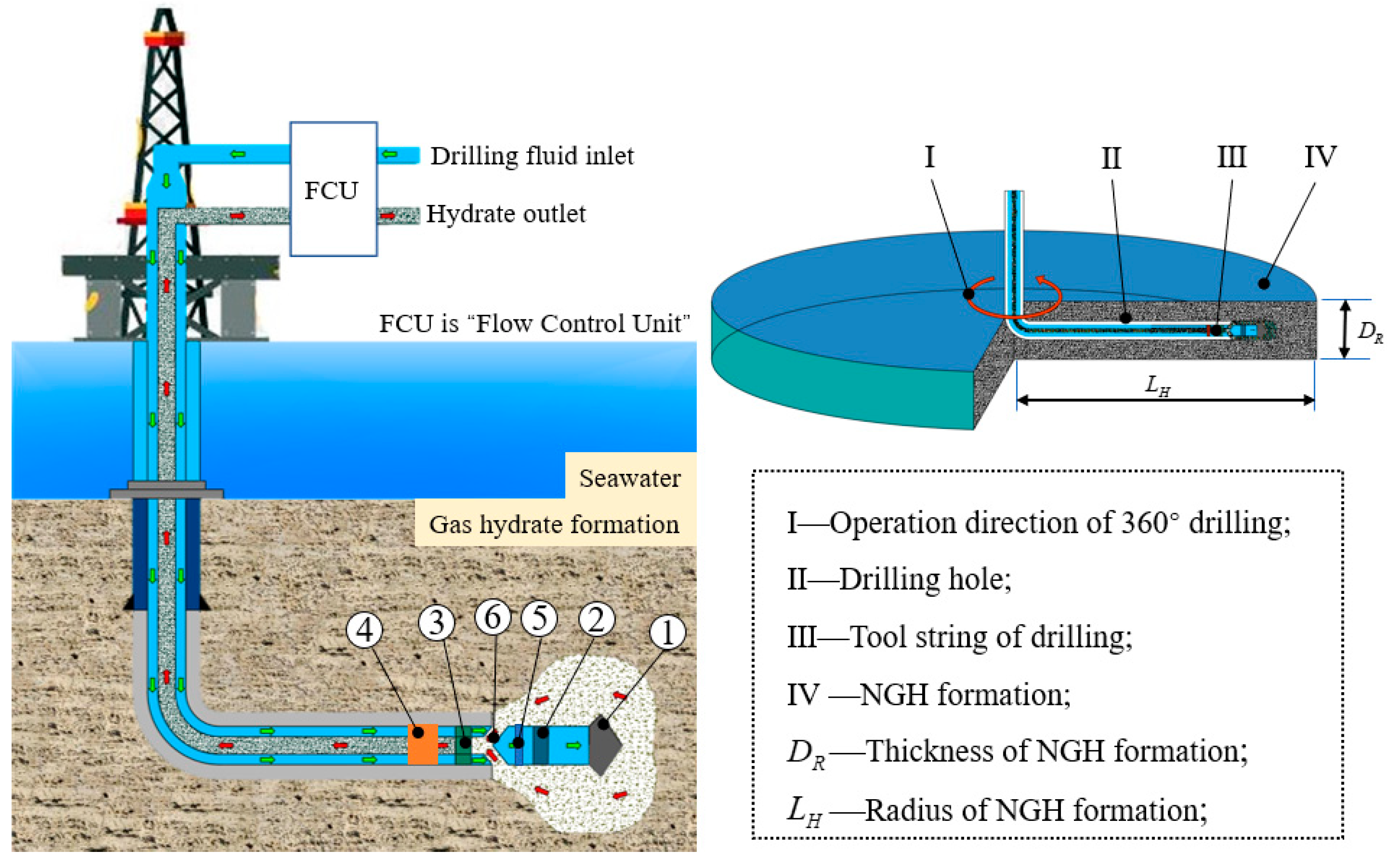
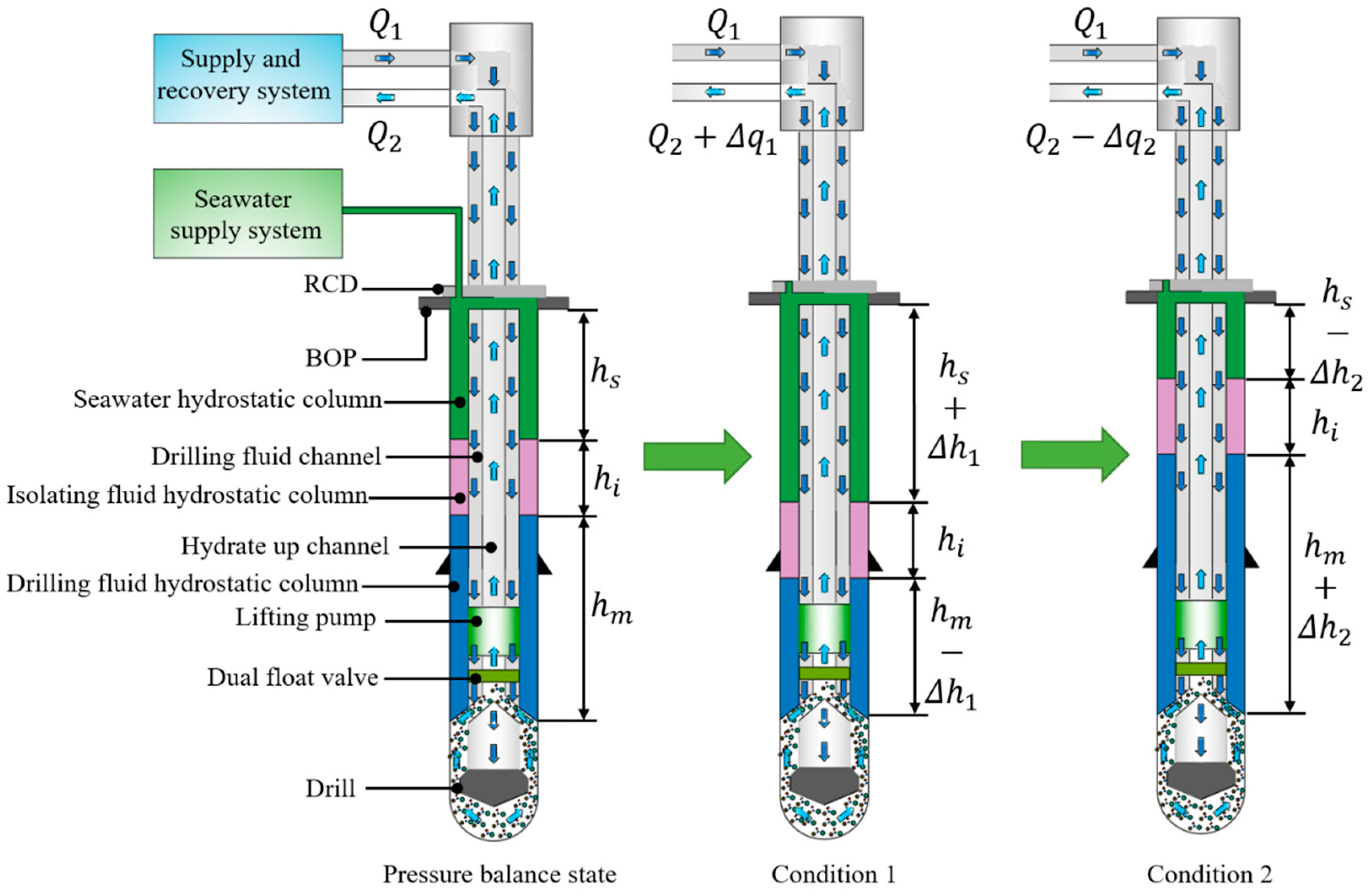
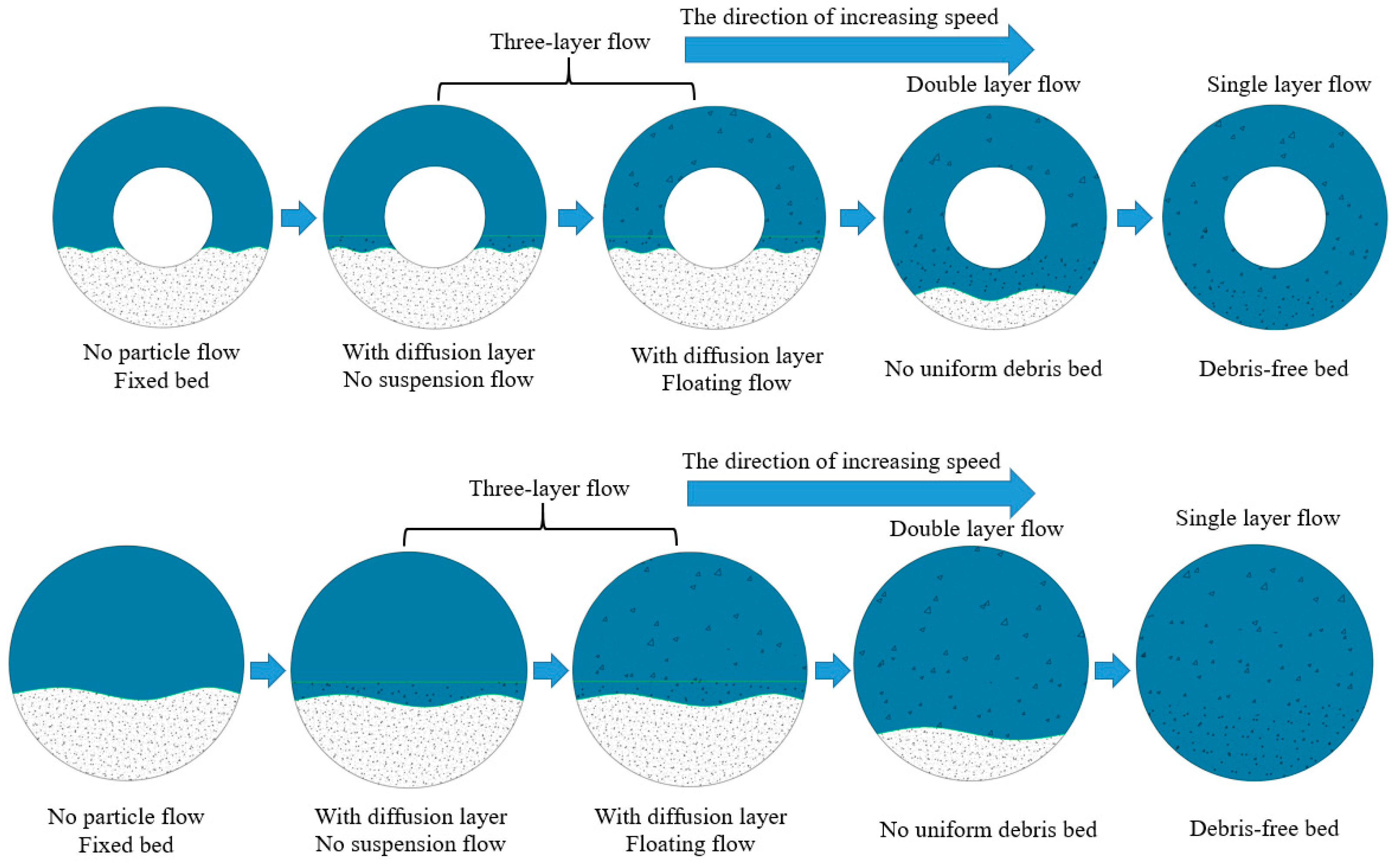
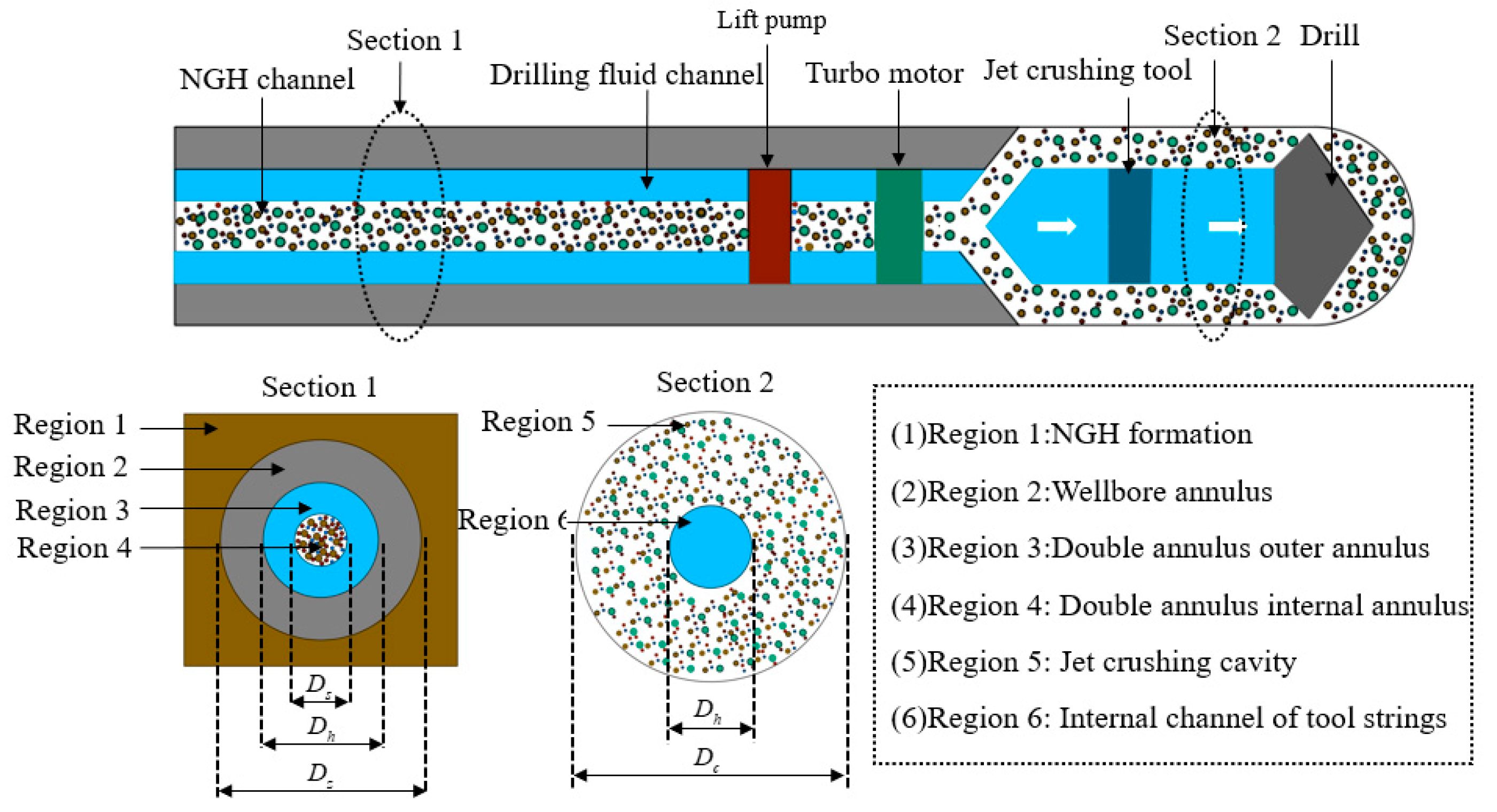
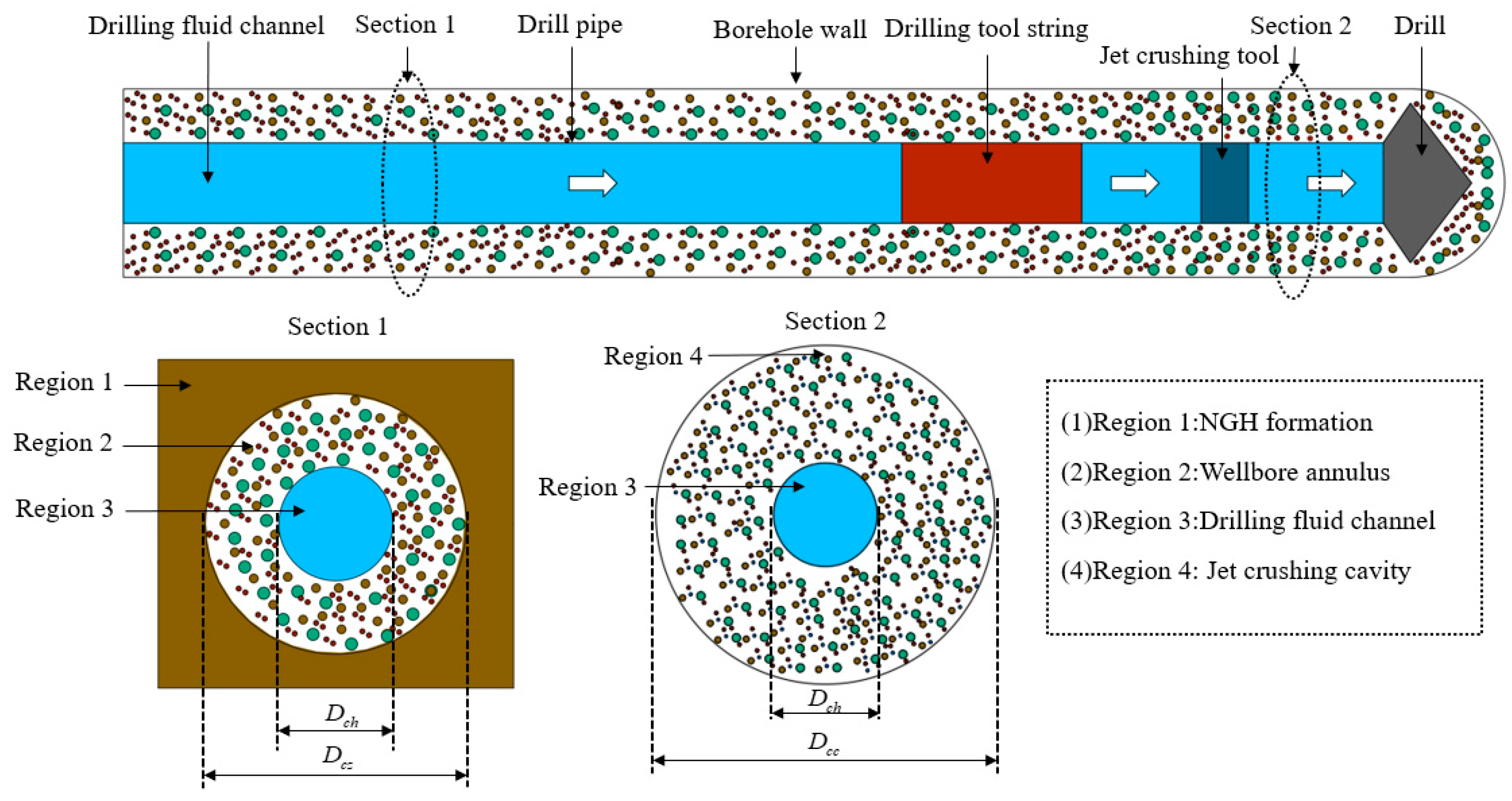
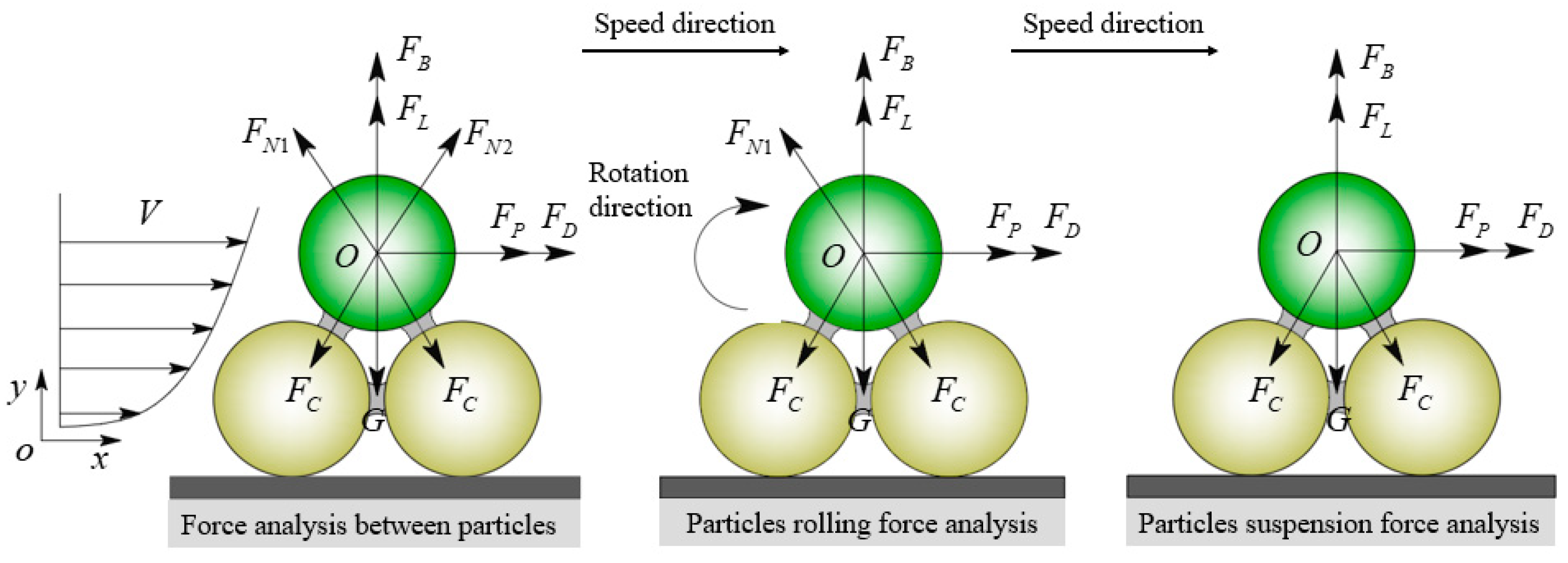

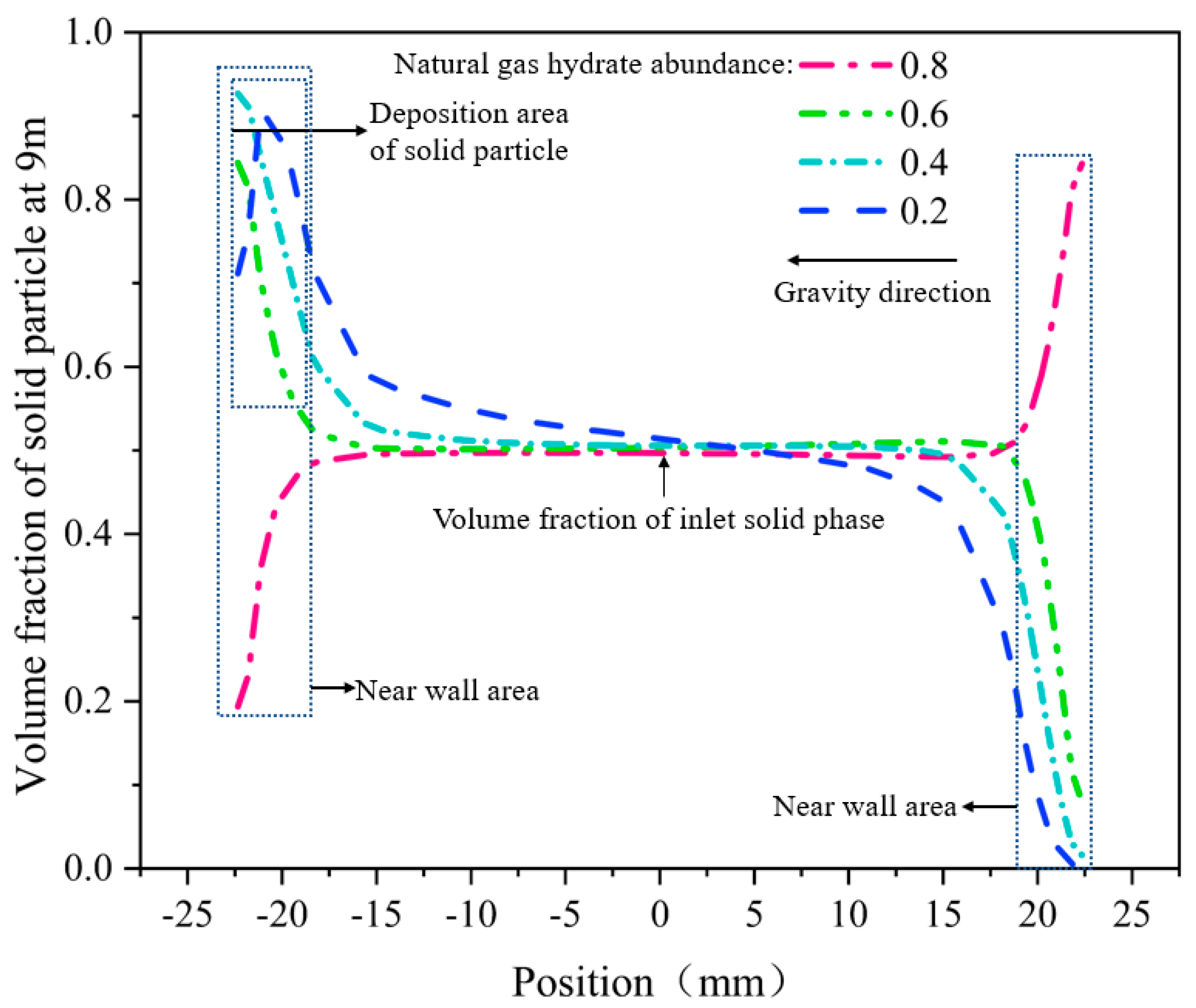


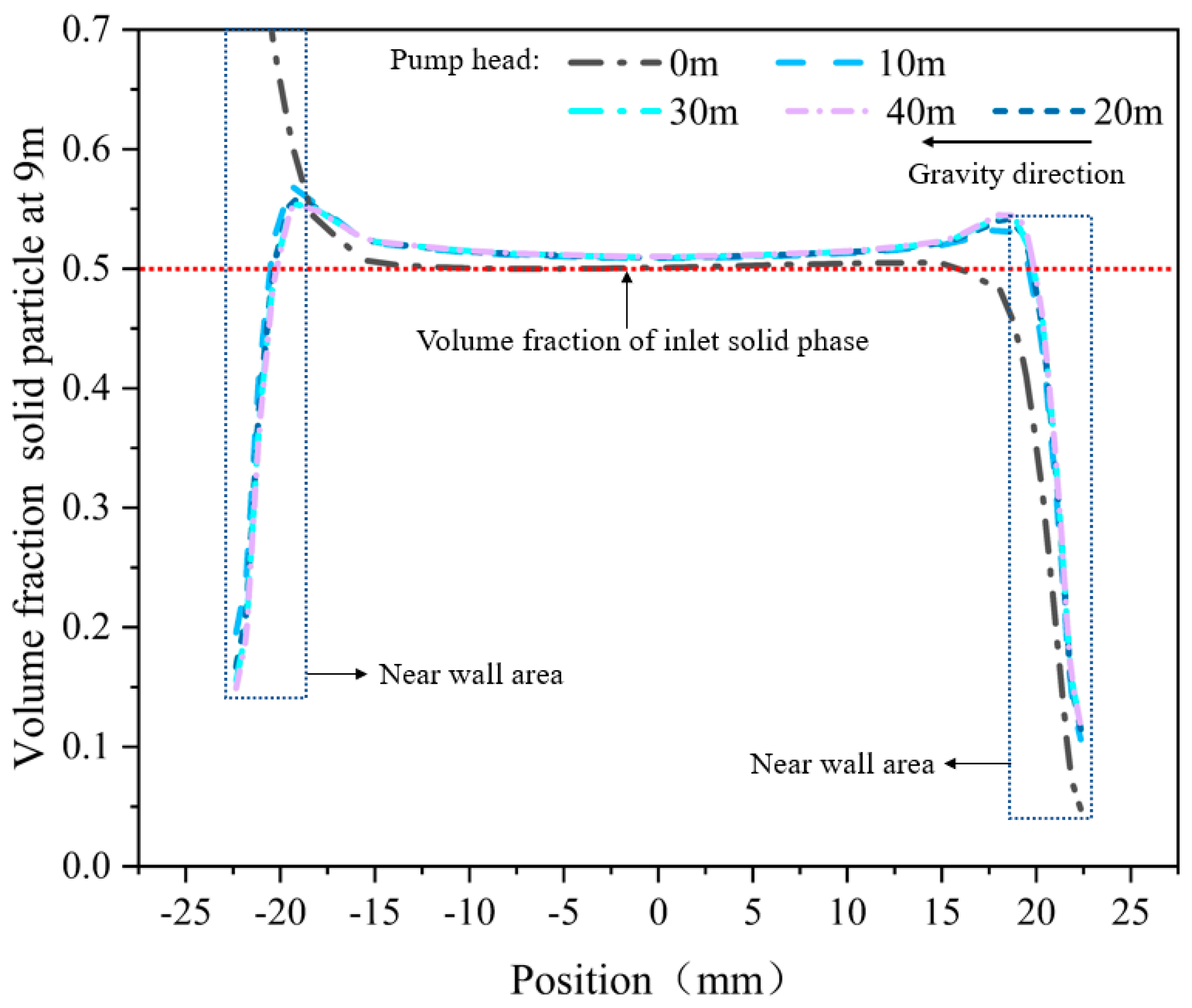
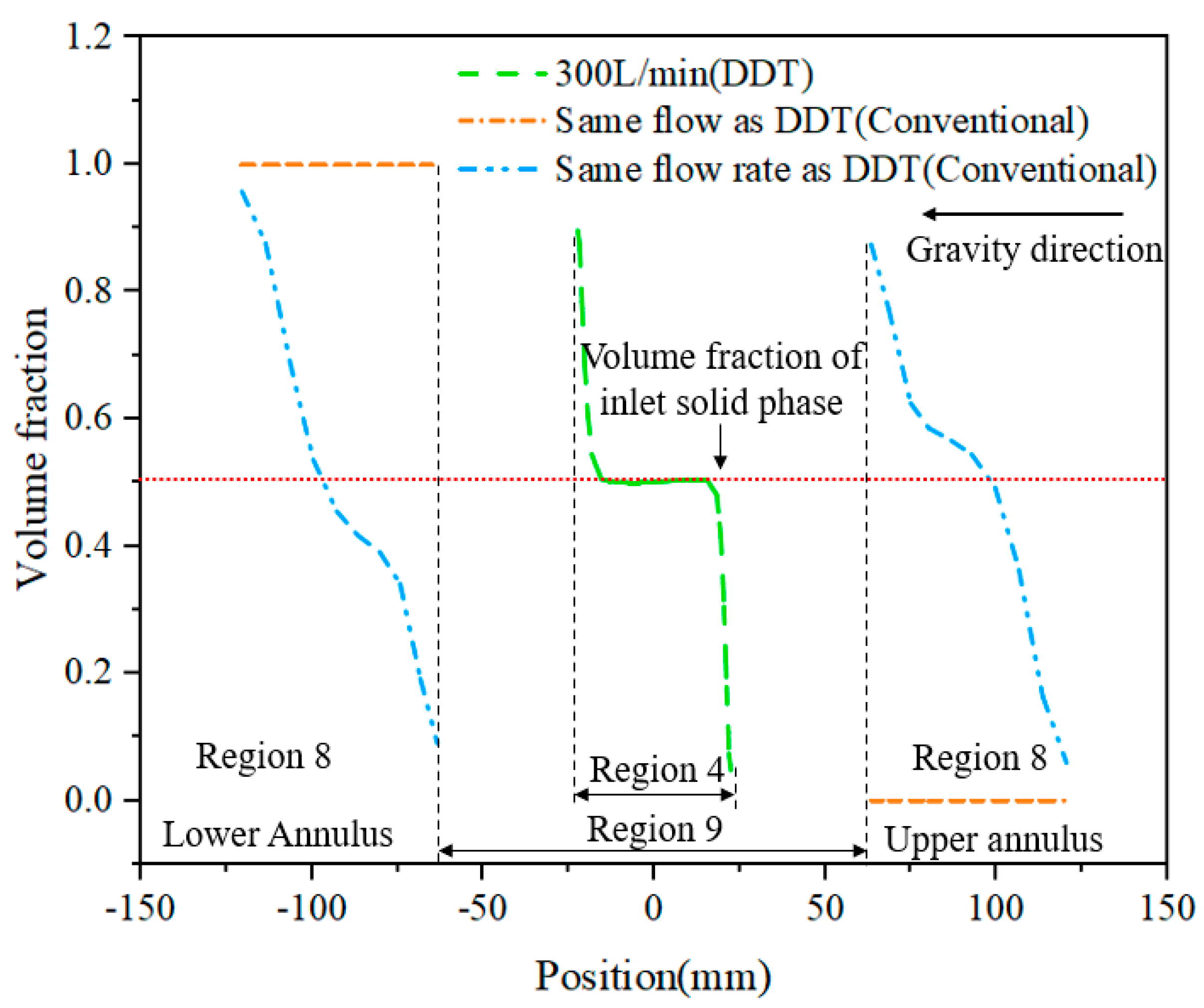
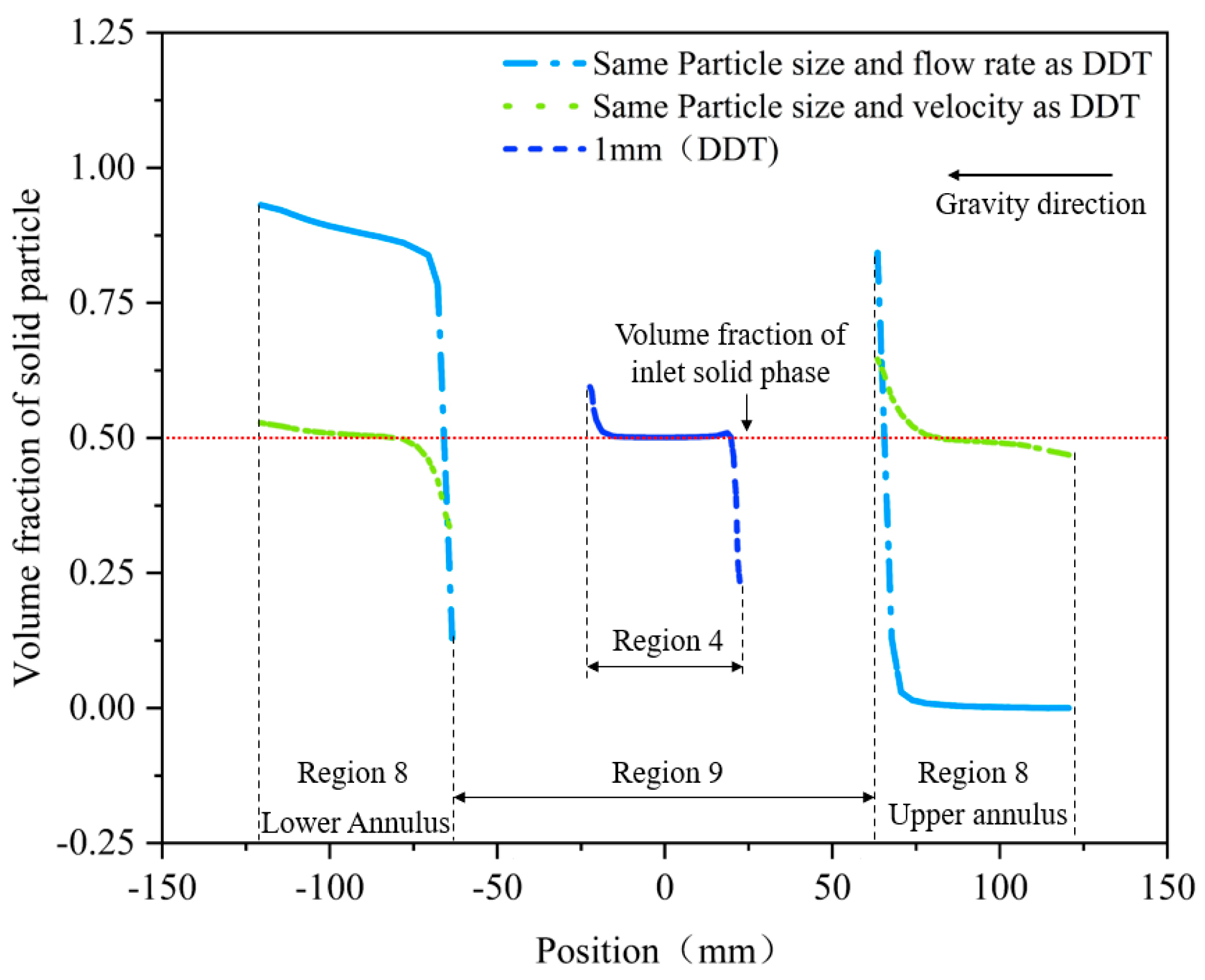
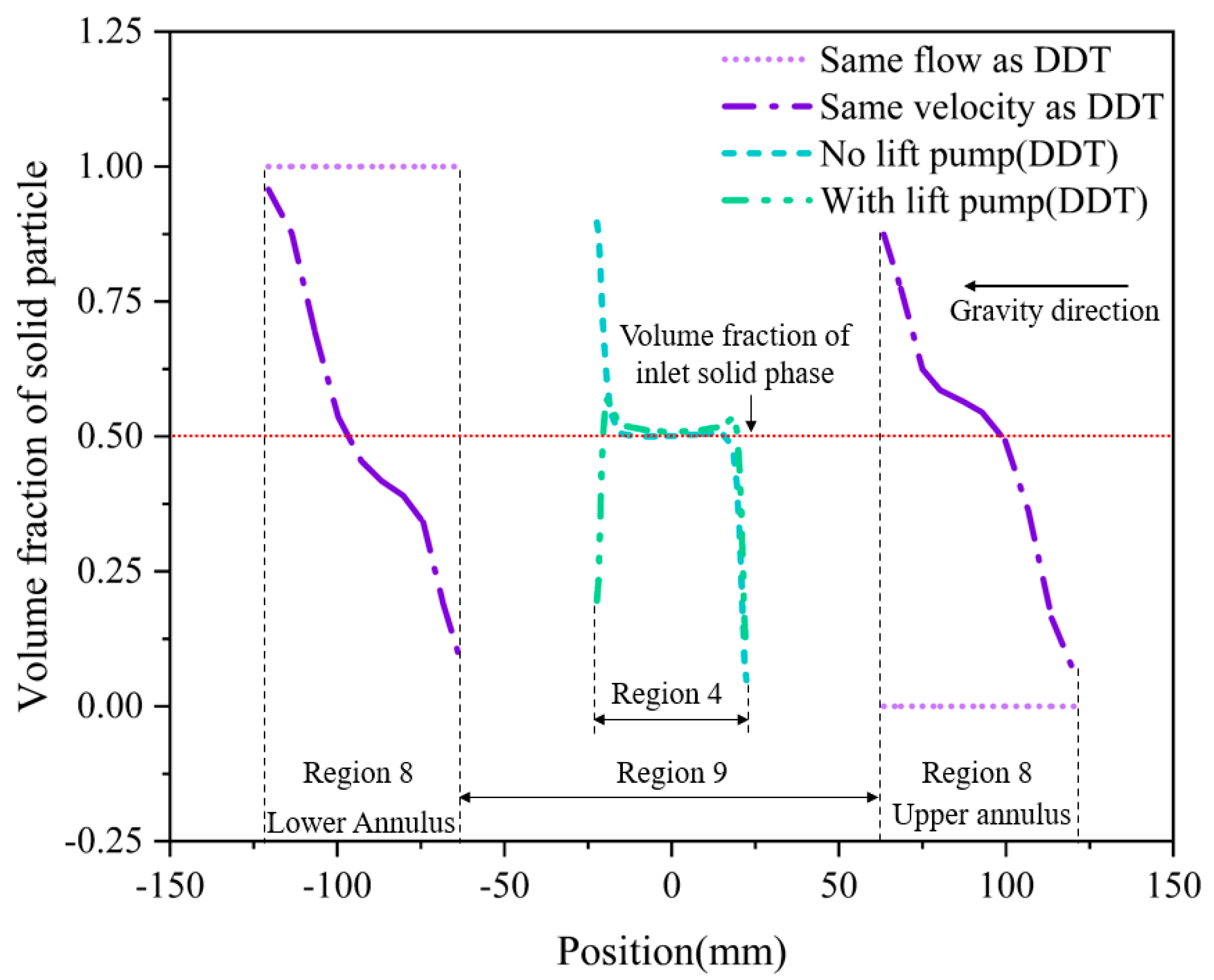
| Number | Name | Function |
|---|---|---|
| 1 | NGH drill bit | Horizontal collar drilling |
| 2 | Pressure controlled sliding sleeve | Control the opening and closing of the jet nozzles |
| 3 | Turbo motor | Provide power for drill bit and lift pump |
| 4 | Subsea lift pump | Control the pressure of wellbore to improve the efficiency of solid particle migration |
| 5 | Test tool | Monitor and collect data of wellbore |
| 6 | Bridge channel | Used for the interaction of the flow channel between the inner and outer tubes of the double-layer continuous pipe |
| Number | DDG Method | Value | Traditional Method | Value |
|---|---|---|---|---|
| 1 | Outer diameter of migration channel | 50.8 mm | Wellbore diameter | 241.3 mm |
| 2 | Inner diameter of migration channel | 44.8 mm | Column diameter | 127 mm |
| 3 | Numeric simulation model length | 10 m | Numeric simulation model length | 10 m |
© 2020 by the authors. Licensee MDPI, Basel, Switzerland. This article is an open access article distributed under the terms and conditions of the Creative Commons Attribution (CC BY) license (http://creativecommons.org/licenses/by/4.0/).
Share and Cite
Tang, Y.; Yao, J.; Wang, G.; He, Y.; Sun, P. Analysis of Multi-Phase Mixed Slurry Horizontal Section Migration Efficiency in Natural Gas Hydrate Drilling and Production Method Based on Double-Layer Continuous Pipe and Double Gradient Drilling. Energies 2020, 13, 3792. https://doi.org/10.3390/en13153792
Tang Y, Yao J, Wang G, He Y, Sun P. Analysis of Multi-Phase Mixed Slurry Horizontal Section Migration Efficiency in Natural Gas Hydrate Drilling and Production Method Based on Double-Layer Continuous Pipe and Double Gradient Drilling. Energies. 2020; 13(15):3792. https://doi.org/10.3390/en13153792
Chicago/Turabian StyleTang, Yang, Jiaxin Yao, Guorong Wang, Yin He, and Peng Sun. 2020. "Analysis of Multi-Phase Mixed Slurry Horizontal Section Migration Efficiency in Natural Gas Hydrate Drilling and Production Method Based on Double-Layer Continuous Pipe and Double Gradient Drilling" Energies 13, no. 15: 3792. https://doi.org/10.3390/en13153792
APA StyleTang, Y., Yao, J., Wang, G., He, Y., & Sun, P. (2020). Analysis of Multi-Phase Mixed Slurry Horizontal Section Migration Efficiency in Natural Gas Hydrate Drilling and Production Method Based on Double-Layer Continuous Pipe and Double Gradient Drilling. Energies, 13(15), 3792. https://doi.org/10.3390/en13153792




